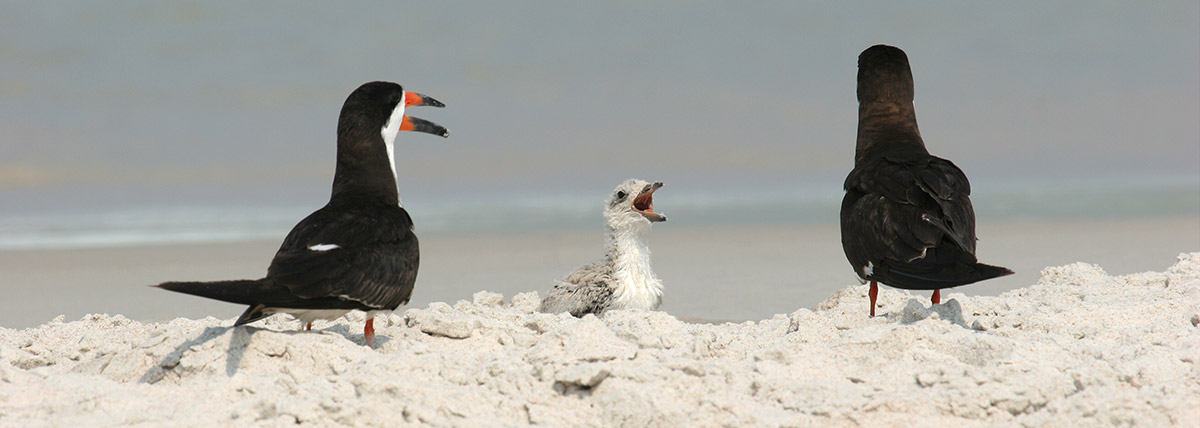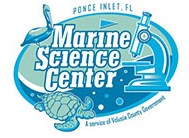MSC HISTORY
 The Marine Science Center is in the Town of Ponce Inlet in Volusia County. Located on Florida’s east coast with its famous Atlantic Ocean beaches and extensive saltwater lagoons, Volusia County is a land sculpted by the sea. This area is home to a magnificent array of wildlife, many of which are listed as endangered or threatened by the U.S. Fish and Wildlife Service. These fragile marine resources are under tremendous pressures from an expanding population, rapid growth, and the millions of tourists and residents who make recreational use of the Volusia County coastal areas.
The Marine Science Center is in the Town of Ponce Inlet in Volusia County. Located on Florida’s east coast with its famous Atlantic Ocean beaches and extensive saltwater lagoons, Volusia County is a land sculpted by the sea. This area is home to a magnificent array of wildlife, many of which are listed as endangered or threatened by the U.S. Fish and Wildlife Service. These fragile marine resources are under tremendous pressures from an expanding population, rapid growth, and the millions of tourists and residents who make recreational use of the Volusia County coastal areas.
The center was established to serve as an important educational institution to improve the public’s understanding of the marine environments of Volusia County. In addition, the county identified an important opportunity to address the concerns of driving on our beaches and the potential impacts of this activity on protected species of sea turtles. The county established the sea turtle rehabilitation center and the bird rehabilitation center to mitigate the impact of beach driving as part of the Habitat Conservation Plan and the Incidental Take Permit (HCP/ITP) developed by the county in concert with the U.S. Fish and Wildlife Service and the Florida Fish and Wildlife Conservation Commission.
The center opened in June 2002 as an initiative of the Volusia County Government to enhance the area’s environmental, cultural, heritage and outdoor (ECHO) awareness opportunities. At the time of opening, the center consisted of the primary education and exhibit area and the sea turtle rehabilitation facility. Initial phases of design and construction cost nearly $1.6 million, with funds contributed by the Florida Inland Navigational District, the Volusia County ECHO program, and the county general fund. In June 2004, the center expanded to include a seabird rehabilitation facility – the Mary Keller Seabird Rehabilitation Sanctuary.
Since opening in 2002, the center has hosted more than 1 million visitors, cared for over 27,000 sea turtles and more than 19,000 birds representing over 200 different species.
The center is housed in an elevated, one-story “cracker-style” facility nestled into a twisted live oak and red bay forest. Components of the facility include a 2,600-square-foot exhibition gallery with exhibits on mangrove, dune, estuarine and jetty ecosystems. Live animal areas and aquariums highlight many species of saltwater fish, exotic species introduced into Florida, freshwater turtles, coral reef ecosystems, a 5,000-gallon artificial reef habitat aquarium, and a 1,300-gallon touch tank featuring cownose rays and other species. Other center components include the classroom/laboratory, sea turtle observation terrace, surgical laboratory, sea turtle rehabilitation areas, the Mary Keller Seabird Rehabilitation Sanctuary, Education and Conservation Raptor Exhibit, nature trail and observation tower, gift shop and restrooms.
The exhibit area of the center includes innovative and dynamic displays. The exhibit hall provides an inviting atmosphere that draws visitors in to discover the wonders of Volusia County’s coastal environments. Individuals of all backgrounds and physical abilities are able to learn from and be inspired by the exhibits.
The center property is home to both sea turtle and seabird rehabilitation facilities. Each area has specialized equipment and infrastructure to house and support the care and management of these Volusia County coastal treasures. The infrastructure includes more than 5,000-gallons of pools for the sea turtles and 6,000-square feet of aviary and bird enclosures for avian rehabilitation.
The center’s classroom and laboratory doubles as public exhibition space with hands-on marine specimens and an array of microscopes where visitors can examine a wide collection of interesting marine subjects. Aquariums house local fish and invertebrates. Marine science programs are continuously held in the classroom to provide additional educational experiences. The space converts to classroom use with 15 microscopes for examining plankton samples or laboratory use for dissections and other activities.
The center includes a gift shop, which offers visitors the opportunity to take a variety of memories home to every visitor. Even the plush animals link the child to the experiences and messages of the center they will not forget. The gift shop provides an important source of revenue for the center.
Once outside the center complex, visitors enjoy a boardwalk through a maritime forest that leads to a two-story observation tower with a spectacular view overlooking Ponce de Leon Inlet. On these paths visitors can watch nature in action in this unique habitat.

 DONATIONS
DONATIONS


